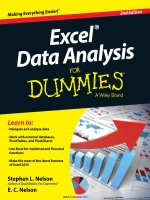technical analysis for dummies 2nd edition
Bạn đang xem bản rút gọn của tài liệu. Xem và tải ngay bản đầy đủ của tài liệu tại đây (27.59 MB, 349 trang )
www.it-ebooks.info
www.it-ebooks.info
About the Author
Barbara Rockefeller is a writer specializing in international economics and
nance, with a focus on foreign exchange. She also trades in the foreign
exchange market. She is the publisher of a daily newsletter on the foreign
exchange market, “The Strategic Currency Brie ng.” Her newsletter combines
technical and fundamental observations. Additionally, she publishes separate
daily “Trader’s Advice” reports for spot and futures foreign exchange trad-
ers. Newsletter subscribers include central banks, investment banks, hedge
funds, multinational corporations, investment managers and individuals.
Miss Rockefeller also prepares custom charts on a consulting basis for indi-
viduals and institutions.
Before starting the newsletter business, Barbara was in the credit, foreign
exchange, and risk-management departments at several U.S. banks, including
Citibank and Brown Brothers Harriman. Conventional economic theory failed
to generate valid currency forecasts at Brown Brothers, which led her to
spearhead a technical analysis system at Citibank. This decision was in 1980,
long before technical analysis went mainstream and at a time when it was
considered at least a little crackpot.
Barbara has a B.A. in Economics from Reed College in Portland, Oregon, and
a M.A. in International Affairs from Columbia University. While at Citibank,
she traveled the world, training staff and clients on the fundamentals of for-
eign exchange, international economics, and risk management. Favorite coun-
try? Turkey. Smartest traders? Hong Kong.
Barbara is the author of How to Invest Internationally, published in Japanese
in 1999 (Franklin Covey), CNBC 24/7, Trading Around the Clock, Around the
World, published in 2000 (John Wiley & Sons), and The Global Trader, pub-
lished in 2001 (John Wiley & Sons). She also writes a monthly column for
Currency Trader Magazine.
www.it-ebooks.info
Dedication
This book is dedicated to Robert James Deadman, founder of Technical
Systems Analysis Group, who taught as much of “the scienti c way of thinking”
as it’s possible to cram into a “social science” mind, and with endless patience.
I also dedicate the book to Alfred A. “Chip” Olbrycht, who forces me to question
the easy way and to look at everything a second time, and a third time, too.
Author’s Acknowledgments
For Dummies editors Mike Baker and Alissa Schwipps, who caused much
suffering. I’m wrung-out, but you, dear reader, have a better book.
And the usual suspects: Jim Sullivan, head of the Fair eld County Technical
Traders’ Club, contributed numerous gentle nudges on perspective as well
as how traders really use indicators and think about trading risk. Ed Dobson,
founder of Traders Press, and Perry Kaufman, author of Trading Systems and
Methods, always generous. Most generous of all over the years is Desmond
MacRae, whose ideas I gladly and routinely steal.
www.it-ebooks.info
Publisher’s Acknowledgments
We’re proud of this book; please send us your comments at .
For other comments, please contact our Customer Care Department within the U.S. at 877-762-2974,
outside the U.S. at 317-572-3993, or fax 317-572-4002.
Some of the people who helped bring this book to market include the following:
Acquisitions, Editorial, and Media
Development
Senior Project Editor: Alissa Schwipps
(Previous Edition: Mike Baker)
Acquisitions Editor: Michael Lewis
Copy Editor: Sarah Westfall
Assistant Editor: David Lutton
Technical Editor: Charles LeBeau
Senior Editorial Manager: Jennifer Ehrlich
Editorial Assistants: Rachelle Amick, Jennette
ElNaggar
Cover Photo: © iStockphoto.com/Nikada
Cartoons: Rich Tennant
(www.the5thwave.com)
Composition Services
Project Coordinator: Sheree Montgomery
Layout and Graphics: Vida Noffsinger,
Lavonne Roberts
Proofreaders: John Greenough, Lindsay
Littrell, Bonnie Mikkelson
Indexer: Estalita Slivoskey
Publishing and Editorial for Consumer Dummies
Diane Graves Steele, Vice President and Publisher, Consumer Dummies
Kristin Ferguson-Wagstaffe, Product Development Director, Consumer Dummies
Ensley Eikenburg, Associate Publisher, Travel
Kelly Regan, Editorial Director, Travel
Publishing for Technology Dummies
Andy Cummings, Vice President and Publisher, Dummies Technology/General User
Composition Services
Debbie Stailey, Director of Composition Services
www.it-ebooks.info
www.it-ebooks.info
www.it-ebooks.info
Technical Analysis For Dummies, 2nd Edition
xii
Chapter 2: Uncovering the Essence of Market Movement. . . . . . . . . .23
The eBay Model of Supply and Demand 23
Securities aren’t socks: The demand effect 24
Creating demand from scratch 24
Identifying Crowd Behavior 25
The individual versus the crowd 26
Playing games with traders’ heads 26
Figuring Out What’s Normal: Considering the Normal Distribution 27
Reverting to the mean 27
Trading mean reversion 28
Identifying and Responding to Crowd Extremes 29
Breaching the limits: Overbought and oversold 30
Going against the grain: Retracements 31
Catch a falling knife: Estimating where
and when a retracement will stop 32
Big-Picture Crowd Theories 34
The Gann 50 percent retracement 35
Magic numbers: “The secret of the universe” 37
Seeing too many retracements 38
Chapter 3: Going with the Flow: Market Sentiment. . . . . . . . . . . . . . . .41
De ning Market Sentiment 42
Getting the Low-Down on Volume 42
Leading the way with spikes 43
Tracking on-balance volume 43
Re ning volume indicators 46
Thinking Outside the Chart 46
Sampling information about sentiment 47
Following the earth’s axis: Seasonality and calendar effects 50
Blindsiding the Crowd 51
Considering historic key reversals 52
Enduring randomness 53
Remembering the last price 53
Thinking Scienti cally 54
Conditions and contingencies 54
Sample size 55
Par t II: Preparing Your Mind for Technical Analysis 57
Chapter 4: Using Indicators to Trade Systematically . . . . . . . . . . . . . .59
Introducing Indicators 59
Classifying indicators 60
Understanding what indicators identify 60
Choosing your trading style 61
www.it-ebooks.info
xiii
Table of Contents
Examining How Indicators Work 63
Finding relevant time frames 64
Heeding indicator signals 65
Establishing Benchmark Levels 67
Choosing Indicators 67
Optimizing: Putting Indicators to the Test 68
Constructing a backtest optimization 69
Re ning a backtest 70
Fixing the indicator 71
Applying the indicator again 72
Evaluating the risks of backtesting 72
Chapter 5: Managing the Trade . . . . . . . . . . . . . . . . . . . . . . . . . . . . . . . . .75
Building Trading Rules 75
Your trading plan outline 76
Common questions and concerns 77
Taking Money off the Table: Establishing the Pro t Target 78
Controlling Losses 79
Using the First Line of Defense: Stop-Loss Orders 80
Mental stops are hogwash 81
Sorting out the types of stops 81
Adjusting Positions 86
Reducing positions 87
Adding to positions 88
Applying stops to adjusted positions 89
Par t III: Observing Market Behavior 91
Chapter 6: Reading Basic Bars: Showing How Security Prices Move . . .93
Building Basic Bars 93
Getting in on the action: The price bar in brief 94
Setting the tone: The opening price 96
Summarizing sentiment: The closing price 98
Going up: The high 101
Getting to the bottom of it: The low 102
Putting It All Together: Using Bars to Identify Trends 102
Identifying an uptrend 103
Pinpointing a downtrend 104
Wading through Murky Bar Waters 104
Paying heed to bar series 105
Understanding relativity 106
Avoiding misinterpretation 107
Knowing when bar reading doesn’t work 108
Looking at Data in Different Time Frames 109
Using daily data 109
Zooming out to a higher time frame 110
Zooming in to a shorter time frame 110
www.it-ebooks.info
Technical Analysis For Dummies, 2nd Edition
xiv
Chapter 7: Reading Special Bar Combinations: Small Patterns . . . .113
Finding Clues to Trader Sentiment 114
Tick and bar placement 114
Types of con gurations 115
Trading range 116
Identifying Common Special Bars 116
Closing on a high note 117
Spending the day inside 117
Getting outside for the day 118
Finding the close at the open 119
Decoding Spikes 119
Grasping Gaps 122
Pinpointing a gap 122
Using primary gaps to your advantage 124
Filling That Gap 128
Using the Trading Range to Deal with Change Effectively 129
Paying attention to a changing range 129
Determining the meaning
of a range change 130
Looking at the average trading range 131
Chapter 8: Redrawing the Price Bar: Japanese Candlesticks. . . . . .137
Appreciating the Candlestick Advantage 138
Dissecting the Anatomy of a Candlestick 138
Drawing the real body 139
Doing without a real body: The doji 140
Catching the shadow 140
Sizing Up Emotions 144
Identifying Special “Emotional Extreme” Candlestick Patterns 145
Interpreting candlestick patterns 145
Turning to reversal patterns 147
Continuation patterns 148
Combining Candlesticks with Other Indicators 150
Trading on Candlesticks Alone 151
Par t IV: Finding Pat terns 153
Chapter 9: Seeing Chart Patterns Through a Technical Lens . . . . . .155
Introducing Patterns 155
Got imagination? 156
Coloring inside the lines 157
Cozying Up to Continuation Patterns 158
Ascending and descending triangles 158
Dead-cat bounce 159
www.it-ebooks.info
xv
Table of Contents
Recognizing Classic Reversal Patterns 160
Double bottom 160
Double tops 162
The ultimate triple top: Head-and-shoulders 163
Evaluating the Measured Move 165
Taking dictation from the pattern 165
Resuming the trend after retracement 167
Measuring from the gap 167
Chapter 10: Drawing Trendlines . . . . . . . . . . . . . . . . . . . . . . . . . . . . . . .169
Looking Closely at a Price Chart 169
Following the Rules with Rule-Based Trendlines 170
Drawing rule-based trendlines 171
Using the support line to enter and exit 171
The other side of the coin: Using resistance to enter and exit 174
Fine tuning support and resistance 175
Playing games with support and resistance lines 176
Drawing Internal Trendlines 177
Rules for drawing a linear regression 178
Identifying trendedness 178
How to use the linear regression 180
Chapter 11: Transforming Channels into Forecasts. . . . . . . . . . . . . . .183
Diving into Channel-Drawing Basics 184
Drawing channels by hand 185
Letting software do the drawing 187
Considering the bene ts of straight-line channels 187
Delving into the drawbacks of straight-line channels 188
Using channels to make pro t and avoid loss 188
Dealing with Breakouts 189
Distinguishing between false breakouts and the real thing 189
Putting breakouts into context 192
Riding the Regression Range 195
Introducing the standard error 195
Drawing a linear regression channel 196
Con rming hand-drawn channels 197
Sizing up the special features of the linear regression channel 198
Discovering the drawbacks of linear regression channels 199
Pivot Point Support and Resistance Channel 199
Calculating the rst zone of support and resistance 200
Using pivot support and resistance 201
Par t V: Flying with Dynamic Analysis 203
Chapter 12: Using Dynamic Lines . . . . . . . . . . . . . . . . . . . . . . . . . . . . . .205
Introducing the Simple Moving Average 205
Starting with the crossover rule 206
Using the moving average level rule 209
www.it-ebooks.info
Technical Analysis For Dummies, 2nd Edition
xvi
Dealing with limitations 211
Magic moving average numbers 213
Adjusting the Moving Average 214
Getting acquainted with moving average types 214
Choosing a moving average type 216
Using Multiple Moving Averages 217
Putting two moving averages into play 217
Trying the three-way approach 219
Delving into Moving Average Convergence and Divergence 221
Calculating convergence and divergence 222
Creating a decision tool 223
Interpreting the MACD 224
Chapter 13: Measuring Momentum. . . . . . . . . . . . . . . . . . . . . . . . . . . . .227
Doing the Math: Calculating Momentum 227
Using the subtraction method 228
Utilizing the rate-of-change method 228
Adding context: Percentage rate of change 230
Pondering the Trickier Aspects of Momentum 231
Smoothing price changes 232
Filtering momentum 232
Applying Momentum 233
Discovering divergence 233
Con rming trend indicators 234
Determining the Relative Strength Index (RSI) 235
Calculating the RSI 235
Picturing RSI 236
Using the Rest of the Price Bar: The Stochastic Oscillator 238
Step 1: Putting a number to the fast stochastic %K 239
Step 2: Re ning %K with %D 240
Fiddling with the stochastic oscillator on the chart 241
Chapter 14: Estimating Volatility . . . . . . . . . . . . . . . . . . . . . . . . . . . . . . .243
Catching a Slippery Concept 243
How volatility arises 244
Low volatility with trending 245
Low volatility without trending 246
High volatility with trending 246
High volatility without trending 246
Measuring Volatility 247
Tracking the maximum move 247
Considering the standard deviation 248
Using the average true range indicator 249
Applying Volatility Measures: Bollinger Bands 250
Applying Stops with Average True Range Bands 252
www.it-ebooks.info
xvii
Table of Contents
Chapter 15: Ignoring Time: Point-and-Figure Charting . . . . . . . . . . . .255
Creating a Point-and-Figure Chart to Visualize What’s Important 256
Putting each move into a column 256
Dealing with box size 257
Drawing the daily chart 259
Applying Patterns 260
Support and resistance 260
Double and triple tops and bottoms 262
Projecting Prices after a Breakout 262
Using vertical price projection 262
Applying horizontal projection 264
Combining Point-and-Figure Techniques with Other Indicators 265
Chapter 16: Combining Techniques . . . . . . . . . . . . . . . . . . . . . . . . . . . .267
Standing the Test of Time: Simple Ideas 267
Adding a New Indicator: Introducing Complexity 269
Choosing a ruling concept 270
Studying a case in complexity 271
Expecting a Positive Result 276
Calculating positive expectancy technically 276
Enhancing positive expectancy by entering
gradually and exiting at once 278
Evaluating Ef cient Entries and Ruthless Exits: Setups 279
Starting off early 279
Exiting the setup game 280
Working hard while trading like a pro 280
Reading promotions carefully 281
Chapter 17: Considering a Trading System . . . . . . . . . . . . . . . . . . . . . .283
De ning a Trading System 284
Meeting the strict requirements 286
Finding your place on the spectrum 287
Discovering Why Mechanical Systems Fail 287
Fooling around with new ideas 288
Backtesting until you’re blue in the face 288
Not knowing your time frame 288
Practicing self sabotage 289
Following Big-Picture Rules 290
Stopping out versus the stop-and-reverse 290
Trading more than one security 290
Don’t trade on too little capital 291
Buying a Trading System 292
Overcoming phony track records 292
Looking under the hood 293
Picking the Tool, Not the Security 293
www.it-ebooks.info
Technical Analysis For Dummies, 2nd Edition
xviii
Par t VI: The Par t of Tens 295
Chapter 18: Ten Secrets of the Top Technical Traders. . . . . . . . . . . .297
Trust the Chart 297
Befriend the Trend 298
Understand That You Make Real Cash Money Only When You Sell 298
Take Responsibility 299
Avoid Euphoria and Despair 299
Focus on Making Money, Not Being Right 300
Don’t Let a Winning Trade Turn into a Losing Trade 300
Sidestep the Temptation to Curve Fit 301
Know When to Hold ‘Em and When to Fold ‘Em 301
Diversify 302
Chapter 19: Ten Rules for Working with Indicators. . . . . . . . . . . . . . .303
Listen to the Price Bars 303
Understand Your Indicator 304
Trade What You See 304
Use Support and Resistance 304
Follow the Breakout Principle 305
Watch for Convergence and Divergence 305
Backtest Your Indicators Properly 305
Acknowledge That Your Indicator Will Fail 306
Accept That No Secret Indicators Exist 306
Play Favorites 306
Chapter 20: Ten Ways the Market Has Changed . . . . . . . . . . . . . . . . .307
Technical Analysis Is Universally Accepted 307
Algorithmic Trading Is on the Rise 308
Foreign Exchange Is More Prevalent 308
Hard Assets Have Revived Interest 309
Intermarket Trading Is Blooming 309
Leverage Is Dangerous 310
Internationalization Is Becoming More Popular 310
Hedge Funds and Sovereign Wealth Funds Are the New Big Dogs 311
Platforms Are Emerging 312
Exchange-Traded Funds Have Made Their Mark 312
Appendix: Additional Resources 313
The Bare Minimum 313
Online resources 313
Charting software 314
Additional Reading 315
Index 317
www.it-ebooks.info
www.it-ebooks.info
2
Technical Analysis For Dummies, 2nd Edition
The good news is that For Dummies books are designed so that you can jump
in anywhere and get the information you need. Don’t feel that you have to
read every chapter — or even the entire chapter. Take advantage of the table
of contents and index to find what you’re looking for, and check it out.
Conventions Used in This Book
To help you navigate this book, I use the following conventions:
✓ Italic is used for emphasis and to highlight new words or terms that are
defined.
✓ Boldfaced text is used to indicate keywords in bulleted lists or the
action part of numbered steps.
✓ Monofont is used for Web addresses.
What You’re Not to Read
I intend for this book to be a pleasant and practical read so that you can
quickly find and absorb the information you want. However, I sometimes
couldn’t help going a little bit deeper or relaying information that expands on
the basics. You might find this information interesting, but you don’t need it
to understand what you came to that section to find.
When you see a sidebar (a gray-shaded box of text) or text flagged with the
Technical Stuff icon, know that the information is optional. You can lead a full
and happy life without giving it a glance. (But aren’t you curious? A little?)
Foolish Assumptions
Every author must make assumptions about her audience, and I’ve made a
few assumptions that may apply to you:
✓ You’ve never put a dime into a security but you plan to; and when you
do, you intend not to lose it.
✓ You’re reasonably well versed in the trading game, but you’re looking for
new tools to become a more effective trader and improve your profits.
✓ You’re tired of the buy-and-hold approach in which your returns seem
unrelated to the supposed quality of the security you bought.
✓ You want to find out how to sell. You know how to buy, but timing your
sales ties you up in knots.
www.it-ebooks.info
3
Introduction
✓ You’ve experienced some setbacks in the market, and you need an
approach to make that money back.
✓ You want to know whether technical analysis has any basis in reason
and logic — or whether all technical analysts are crackpots.
If any of these descriptions fits the bill, then you’ve picked up the right book.
How This Book Is Organized
I’ve arranged Technical Analysis For Dummies into six parts. Parts I and II
introduce you to the field of technical analysis, and Parts III through V intro-
duce you to nuts and bolts — the indicators. What’s that leave? The famous
For Dummies Part of Tens — Part VI.
Part I: Defining Technical Analysis
The point of technical analysis is to help you observe prices in a new way
and to make trading decisions based on reasonable expectations about
where “the market” is going to take the price. This part shows you how to
view security prices as the outcome of crowd psychology.
Part II: Preparing Your Mind
for Technical Analysis
Before you plunge into risking hard-earned cash on securities trading, you have
to realize that it’s not the security that counts; it’s the trade. Each trade has two
parts — the price analysis and you. Price analysis tools are called indicators, and
you have to select the indicators that match your personality and preference
for risk. But most people don’t know their risk preference when they start out
in securities trading (which changes over time, anyway), so you have a chicken-
and-egg situation. By studying the kinds of profit and loss outcomes that each
type of indicator delivers, you can figure out your risk preferences.
Part III: Observing Market Behavior
The price bar and its placement on the chart deliver a ton of information
about market sentiment. It doesn’t take much practice to start reading the
mind of the market by looking at bars and small patterns. The payoff is cold,
hard cash, but you have to be patient, imaginative, and thoughtful.
www.it-ebooks.info
www.it-ebooks.info
www.it-ebooks.info
6
Technical Analysis For Dummies, 2nd Edition
www.it-ebooks.info
www.it-ebooks.info
www.it-ebooks.info
www.it-ebooks.info
www.it-ebooks.info
www.it-ebooks.info









